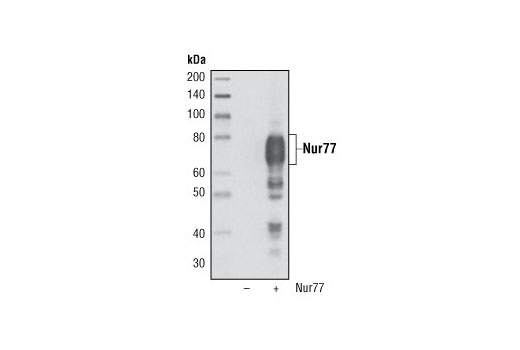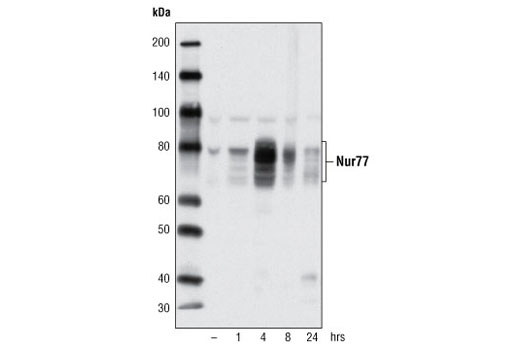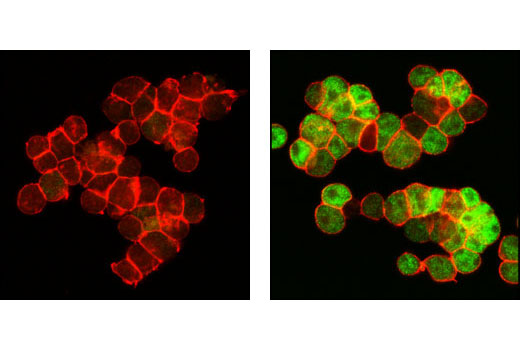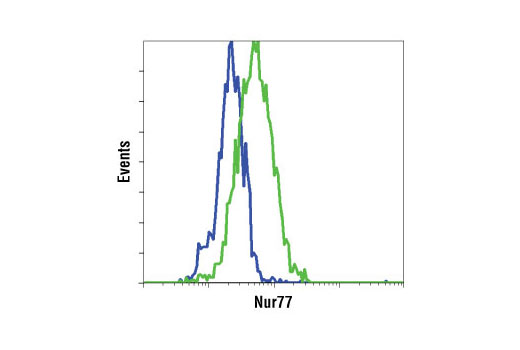WB, IP, IF-IC, FC-FP
H
Endogenous
70-80
Rabbit IgG
#P22736
3164
Product Information
Product Usage Information
| Application | Dilution |
|---|---|
| Western Blotting | 1:1000 |
| Immunoprecipitation | 1:100 |
| Immunofluorescence (Immunocytochemistry) | 1:100 - 1:200 |
| Flow Cytometry (Fixed/Permeabilized) | 1:400 |
Storage
Specificity / Sensitivity
Species Reactivity:
Human
Source / Purification
Monoclonal antibody is produced by immunizing animals with a synthetic peptide corresponding to residues surrounding Leu535 of human Nur77.
Background
Nur77, also known as TR3 and NGFI-B, is an immediate-early response gene and an orphan member of the steroid/thyroid/retinoid receptor superfamily (1-3). Nur77 is composed of an amino-terminal transactivation domain, a central DNA-binding domain and a carboxy-terminal ligand-binding domain. Expression of Nur77 is rapidly induced by a variety of stimuli, including apoptotic, mitogenic and stress signals (1-6). It has been proposed to have many functions related to cell proliferation, differentiation and apoptosis. Nur77 has been extensively studied in T cells where it has been implicated in the process of negative selection and TCR-mediated apoptosis (5,6). Nur77 binds to specific DNA elements leading to the regulation of target genes (7). As a possible mechanism for regulating apoptosis, Nur77 can induce the expression of apoptotic genes such as FasL and TRAIL (8,9). Nur77 is heavily phosphorylated by multiple kinases, which may affect its transactivation activity as well as its subcellular localization (4,10,11). Translocation of Nur77 from the nucleus to the mitochondria can regulate its association with Bcl-2 and control the release of cytochrome c, thereby triggering apoptosis (12,13).
- Hazel, T.G. et al. (1988) Proc. Natl. Acad. Sci. USA 85, 8444-8448.
- Chang, C. and Kokontis, J. (1988) Biochem. Biophys. Res. Commun. 155, 971-977.
- Milbrandt, J. (1988) Neuron 1, 183-188.
- Fahrner, T.J. et al. (1990) Mol. Cell. Biol. 10, 6454-6459.
- Liu, Z.G. et al. (1994) Nature 367, 281-284.
- Woronicz, J.D. et al. (1994) Nature 367, 277-281.
- Wilson, T.E. et al. (1991) Science 252, 1296-1300.
- Weih, F. et al. (1996) Proc. Natl. Acad. Sci. USA 93, 5533-5538.
- Rajpal, A. et al. (2003) EMBO J. 22, 6526-6536.
- Hirata, Y. et al. (1993) J. Biol. Chem. 268, 24808-24812.
- Hazel, T.G. et al. (1991) Mol. Cell. Biol. 11, 3239-3246.
- Li, H. et al. (2000) Science 289, 1159-1164.
- Lin, B. et al. (2004) Cell 116, 527-540.
Species Reactivity
Species reactivity is determined by testing in at least one approved application (e.g., western blot).
Western Blot Buffer
IMPORTANT: For western blots, incubate membrane with diluted primary antibody in 5% w/v BSA, 1X TBS, 0.1% Tween® 20 at 4°C with gentle shaking, overnight.
Applications Key
WB: Western Blotting IP: Immunoprecipitation IF-IC: Immunofluorescence (Immunocytochemistry) FC-FP: Flow Cytometry (Fixed/Permeabilized)
Cross-Reactivity Key
H: human M: mouse R: rat Hm: hamster Mk: monkey Vir: virus Mi: mink C: chicken Dm: D. melanogaster X: Xenopus Z: zebrafish B: bovine Dg: dog Pg: pig Sc: S. cerevisiae Ce: C. elegans Hr: horse GP: Guinea Pig Rab: rabbit All: all species expected
Trademarks and Patents
Limited Uses
Except as otherwise expressly agreed in a writing signed by a legally authorized representative of CST, the following terms apply to Products provided by CST, its affiliates or its distributors. Any Customer's terms and conditions that are in addition to, or different from, those contained herein, unless separately accepted in writing by a legally authorized representative of CST, are rejected and are of no force or effect.
Products are labeled with For Research Use Only or a similar labeling statement and have not been approved, cleared, or licensed by the FDA or other regulatory foreign or domestic entity, for any purpose. Customer shall not use any Product for any diagnostic or therapeutic purpose, or otherwise in any manner that conflicts with its labeling statement. Products sold or licensed by CST are provided for Customer as the end-user and solely for research and development uses. Any use of Product for diagnostic, prophylactic or therapeutic purposes, or any purchase of Product for resale (alone or as a component) or other commercial purpose, requires a separate license from CST. Customer shall (a) not sell, license, loan, donate or otherwise transfer or make available any Product to any third party, whether alone or in combination with other materials, or use the Products to manufacture any commercial products, (b) not copy, modify, reverse engineer, decompile, disassemble or otherwise attempt to discover the underlying structure or technology of the Products, or use the Products for the purpose of developing any products or services that would compete with CST products or services, (c) not alter or remove from the Products any trademarks, trade names, logos, patent or copyright notices or markings, (d) use the Products solely in accordance with CST Product Terms of Sale and any applicable documentation, and (e) comply with any license, terms of service or similar agreement with respect to any third party products or services used by Customer in connection with the Products.




